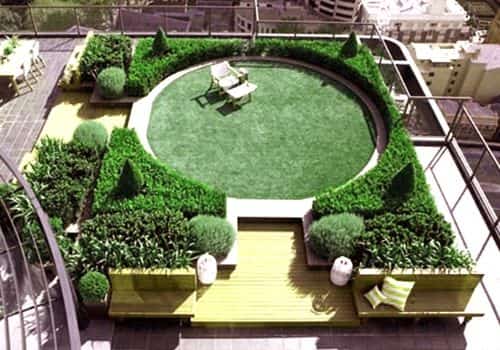Roof Garden
A roof garden is a garden on the roof of a building. Roof planting makes an important contribution to ecology and improving the microclimate, but we need to stop extolling the virtues of vegetable gardens on roofs. It is essentially a garden on the rooftop of building, man-made green spaces on the topmost level of residential and commercial structures. Besides the decorative benefit, roof plantings may provide food, temperature control, hydrological benefits, architectural enhancement, habitats, or corridors for wildlife, recreational opportunities, and on a large scale, it may even have ecological benefits. You need to plan beforehand the amount of space you want to use for your gardening. It depends on the amount of space and the kinds of plants and trees you can implant on your rooftop.
Roof Garden is essentially a garden on the rooftop of building, man-made green spaces on the topmost level of residential and commercial structures.
The practice of cultivating food on the rooftop of buildings is sometimes referred to as rooftop farming. People need a green environment to live in and to stay healthy. Roof gardens contribute to more green and allow us to experience the seasons. They improve the microclimate and bring the human scale back to urban environments. Rooftop gardens have been in existence for a long time now. The people of ancient Mesopotamia have grown trees and shrubs atop ziggurats.

Creating a rooftop garden seems costly if one doesn’t know where to start. That’s why a consultation from professionals–architects, landscape designers, and structural engineers–is needed. In a roof garden, do not plant large trees. Use herbs or shrubs for your gardening. In these cases, you can use hybrid saplings or a grafting method. Water the plants regularly inside your roof garden and drain them properly. If you water them twice a day, make 5-6 holes at the bottom of the tubs. Otherwise, the water will accumulate and the roots may start rotting. Spray water on the leaves twice a week. Apply fertilizer to the plants regularly. With regards to maintenance, take into consideration the types of plants and seasonality to determine the substrate and drainage systems to use.
The roof does not only provide shelter from the rain, protect us from heat and keep the house cool, nowadays it can also prevent flooding by buffering water. Rooftop farming is usually done using green roofs, hydroponics, aeroponics or air-dynaponics systems, or container gardens. Making the rooftop useful and green increases the value of your property. Moreover, a rooftop garden makes roofs useful as grounds for social activities such as play and picnics, and even for relaxation.
















